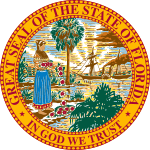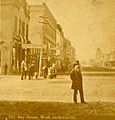Timeline of Jacksonville, Florida facts for kids
A timeline of the history of Jacksonville, Florida, a big city in Florida, USA. This timeline shows important events that happened in Jacksonville over the years.
Jacksonville's Early Days: Before the 1900s
Quick facts for kids History of Florida |
|
|---|---|

The seal of Florida reflects the state's Native American ancestry
|
|
| Historical Periods | |
| Pre-history | until 1497 |
| Spanish Rule | 1513–1763 |
| British Rule | 1763–1783 |
| Spanish Rule | 1783–1821 |
| U.S. Territorial Period | 1822–1845 |
| Statehood | 1845–present |
| Major Events | |
| American Revolutionary War | 1775–1783 |
| War of 1812 | 1811–1814 |
| First Seminole War | 1817–1818 |
| Capitol moved to Tallahassee |
1824 |
| Second Seminole War | 1835–1842 |
| Constitutional convention | 1838 |
| Third Seminole War | 1855–1858 |
| Ordinance of Secession | 1861 |
| Civil War | 1861–1865 |
| 3rd Constitution | 1865 |
| Reconstruction | 1865–1868 |
| 4th Constitution | 1868 |
| 5th Constitution | 1885 |
| Great Migration | 1910–1930 |
| Land Boom | 1925–1929 |
| 6th Constitution | 1968 |
| Gore v. Harris 2000 Presidential Election |
2000 |
| Timeline | |
- Before 1564 – An old map shows a village called Ossachite where downtown Jacksonville is now. This might be the first recorded name for the area.
- 1564 – The French built Fort Caroline. It was started by René Goulaine de Laudonnière.
- 1565 – Spanish forces took over Fort Caroline.
- 1822
- The settlement was named "Jacksonville" to honor Andrew Jackson.
- The town's streets were planned out in a grid.
- Jacksonville became the main city for the new Duval County.
- 1832
- The town officially became a city.
- William J. Mills became the first mayor.
- 1838 – Bethel Baptist Church was started.
- 1845 – Florida became a part of the United States.
- 1846 – October 12: A big storm called a gale hit the city.
- 1857 – City Park was created.
- 1858 – The Florida, Atlantic & Gulf Central Railroad started running trains.
- 1862 – The town was taken over by Union soldiers during the American Civil War.
- 1869 – The St. James Hotel was built.
- 1871 – Furchgott, Benedict & Co., a dry goods store, opened for business.
- 1872 – Cookman Institute, a school, was established.
- 1873 – The Florida Circulating Library was active.
- 1875 – The Windsor Hotel was built.
- 1876
- Duval High School was established.
- The Union Congregational Church was built.
- 1877 – A Board of Health was created to help keep people healthy.
- 1878 – The Library and Literary Association was formed.
- 1881 – The Florida Daily Times newspaper began publishing.
- 1882
- A synagogue (Jewish house of worship) was dedicated.
- Florida Baptist Academy was established.
- 1884 – A Board of Trade was organized to help businesses.
- 1885 – The Park Opera House opened.
- 1886 – The Boylan Industrial Home and school was established.
- 1887
- A yellow fever epidemic (a serious illness) spread.
- The Metropolis newspaper began publishing.
- St. Andrew's Episcopal Church was built.
- 1888 – The Subtropical Exposition was held, like a big fair.
- 1890 – The city's population was 17,201 people.
- 1892 – Edward Waters College was active.
- 1893 – Streetcars (like small trains on city streets) started running.
- 1897 – The Woman's Club was founded.
- 1900
- The famous song "Lift Every Voice and Sing" was performed for the first time.
- The population grew to 28,429 people.
The 1900s: A Century of Growth
Early 1900s to Mid-Century (1900-1950s)
- 1901
- May 3: The Great Fire of 1901 happened, a huge fire that destroyed much of the city.
- Brewster Hospital was established.
- The Continental Hotel opened.
- 1903
- Mason Park opened.
- The Florida Automobile Association was organized.
- 1904
- Lincoln Park opened.
- First Baptist Church was built.
- 1905
- The Jacksonville Free Public Library opened.
- A Protestant Union Revival was held.
- 1907
- Manhattan Beach opened.
- Dixieland Amusement Park opened in South Jacksonville.
- South Jacksonville became its own city.
- 1908 – Filmmaker Kalem Studios was active in the city.
- 1909 – The YMCA building was constructed.
- 1910
- Atlantic Boulevard was planned and built.
- The population reached 57,699 people.
- 1912
- The St. James Building was constructed.
- The City Rotary Club was formed.
- 1914 – The Jacksonville Zoological Park (the zoo) was established.
- 1917
- The National Association for the Advancement of Colored People (NAACP) started a chapter in Jacksonville.
- John W. Martin became mayor.
- 1920 – The population was 91,558 people.
- 1921 – The St. Johns River Bridge opened, connecting parts of the city.
- 1923 – John T. Alsop became mayor.
- 1925
- The Negro Welfare League was organized.
- WJAX radio began broadcasting.
- 1926 – The Carling Hotel opened.
- 1927 – The Florida Theatre and 5 Points Theatre were built.
- 1928 – The Gator Bowl Stadium was built.
- 1929 – The Jacksonville Historical Society was founded to preserve the city's history.
- 1930 – The population was 129,549 people.
- 1934
- Jacksonville Junior College was established.
- WMBR radio began broadcasting.
- 1938
- WJHP radio began broadcasting.
- Theatre Jacksonville was built.
- 1940
- The U.S. military's Naval Air Station Jacksonville was opened.
- The population was 173,065 people.
- 1946 – The annual Gator Bowl college football game began.
- 1947
- The Jacksonville Urban League was formed.
- Hanna Park was created.
- 1949
- WJXT (television) began broadcasting.
- W. Haydon Burns became mayor.
- 1950 – The population reached 204,517 people.
- 1953 – The Mathews Bridge opened.
- 1955 – The Jacksonville Expressway Authority was established to manage roads.
- 1957 – WFGA-TV (television) began broadcasting.
Later 1900s: Big Changes (1960s-1990s)
- 1960
- August: "Ax Handle Saturday" was a time of important events for civil rights.
- The population was 201,030 people.
- 1962 – The Civic Auditorium opened.
- 1963 – December: The Hotel Roosevelt fire occurred.
- 1964 – September 10: Hurricane Dora hit the city.
- 1967
- The Hart Bridge opened.
- Mary Singleton and Sallye B. Mathis became the first African American women elected to the City Council.
- 1968
- The city and Duval County governments joined together in a process called Consolidation.
- Hans Tanzler became mayor.
- 1970 – The population grew to 528,865 people after consolidation.
- 1973 – The Florida Municipal Home Rule Powers Act was approved, giving cities more local control.
- 1979 – Jake Godbold became mayor.
- 1980
- A Foreign trade zone was established to help international business.
- The population was 540,920 people.
- 1984 – The Jacksonville Bulls football team was formed.
- 1989 – The Jacksonville Skyway, an elevated train system, began operating.
- 1990 – The population was 635,230 people.
- 1993 – Corrine Brown became a U.S. representative for Florida's 3rd congressional district.
- 1995
- The Jacksonville Jaguars football team was formed.
- The Jacksonville Municipal Stadium opened.
- John Delaney became mayor.
- 1998 – The city's website went online around this time.
- 2000
- The "Better Jacksonville Plan" was approved to help the city grow and improve.
- The population reached 735,617 people.
The 2000s and Beyond
- 2001 – Ander Crenshaw became a U.S. representative for Florida's 4th congressional district.
- 2003 – May 13: The Jacksonville mayoral election, 2003 was held, and John Peyton won.
- 2010 – The population was 821,784 people.
- 2011 – March 22: The Jacksonville mayoral election, 2011 was held, and Alvin Brown won. He was the city's first elected African-American mayor.
- 2013 – Corrine Brown became a U.S. representative for Florida's 3rd congressional district again.
- 2015 – Lenny Curry became mayor.
- 2022 – Jacksonville celebrated its 200th birthday (bicentennial).
- 2023 – May 16: The 2023 Jacksonville mayoral election was held, and Donna Deegan won. She became the city's first female mayor.
- 2023 – August 26: A sad event occurred with a mass shooting at a Jacksonville Dollar General store.
Images for kids

All content from Kiddle encyclopedia articles (including the article images and facts) can be freely used under Attribution-ShareAlike license, unless stated otherwise. Cite this article:
Timeline of Jacksonville, Florida Facts for Kids. Kiddle Encyclopedia.


